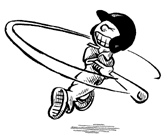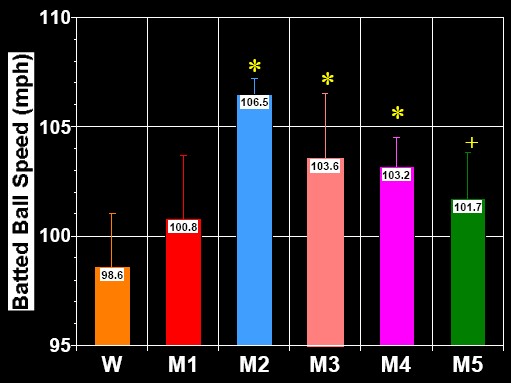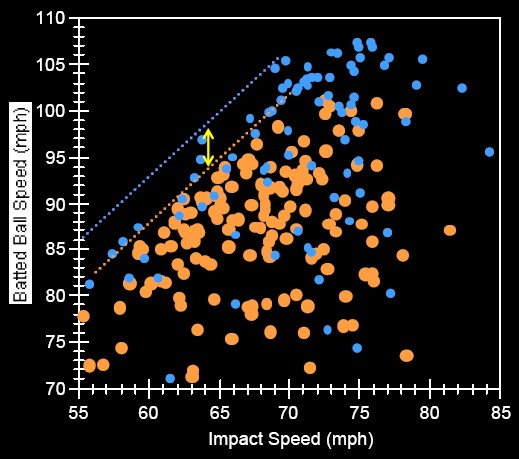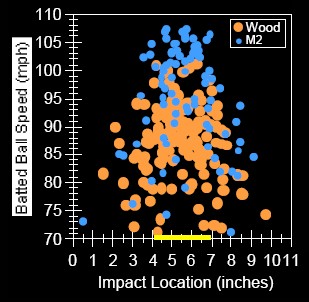
|
Physics and Acoustics of Baseball & Softball Bats
Daniel A. Russell, Ph.D. Graduate Program in Acoustics The Pennsylvania State University The contents of this page are ©2003-2011 Daniel A. Russell | 
|

|
Physics and Acoustics of Baseball & Softball Bats
Daniel A. Russell, Ph.D. Graduate Program in Acoustics The Pennsylvania State University The contents of this page are ©2003-2011 Daniel A. Russell | 
|


The purpose of this document is not to argue for or against aluminum bats. The controversial topic of safety and the metal versus aluminum debate is something I would like to stay away from, especially since I have nothing significant to add to the discussion. Instead I would like to look at the physics of baseball bats and investigate the scientific data to support the claim that metal bats perform better than wood bats. In other words, I simply want to provide an explanation, backed up with experimental evidence, why it might be possible for a metal bat to outperform a wood bat.
Scientific evidence that batted ball speed is faster for aluminum baseball bats.
Given the amount of controvery over the metal versus wood bat issue, there have been surprisingly few scientific studies comparing the performance of wood and metal baseball bats. There is one paper from 1977, when aluminum bats were just beginning to assert their prominence, which concluded that the batted ball speed of an aluminum baseball bat was about 3.85 mph faster than a wood baseball bat.[1] The study was conducted with six skilled college players during more than a dozen batting practice sessions over a 5-day period. Each player would take several swings with either a wood or aluminum bat (randomly chosen), rest for 10 minutes, then take several swings with the other bat. Balls were pitched from both pitching machines and regular batting practice pitchers, but pitchers were found to be more consistent. During the testing, the average pitched ball speed was 56.6 mph. Batted ball speeds were measured using a radar gun. Data was collected for each player until 30 line drives were produced within a certain range of locations in the outfield. The results were an average batted ball speed (for line drives) of 88.6 mph for the wood bat and 92.5 mph for the aluminum bat. A second phase of the study attempted to explain the increase in performance of the aluminum bat by comparing the size of the "sweet spot" for the two bats by locating the center-of-percussion. The study found that the aluminum bat appeared to have a larger COP than the wood bat.
In contrast to the 1977 study, a 1989 study concluded that metal bats did not outperform wood bats.[2] In this study balls were shot from a pitching machine towards bats held stationary (without swinging) in the hands of a player. The 1989 study found that the rebound speed of the ball depended strongly on impact location, and somewhat on how strongly the player was gripping the bat. A third study in the early 1990's also concluded that metal bats performed no better than wood bats.[3] This third study compared four baseball bats: two wood, one aluminum, and one composite. Balls were pitched towards an initially stationary bat and the rebound speed of the ball was measured, with the result that aluminum and wood bats performed the same. The results of these two studies are in contrast to what players, coaches, and league officials all know - that metal bats do outperform wood bats. The apparent discrepency appears to be that "Despite the amount of controversy generated, there are presently no available data describing the performance of metal and wood bats in the field.[4] Studies which throw pitched balls at stationary bats do not seem capable of reproducing field conditions which bring out the enhanced performance of aluminum bats.
 Figure 1. Measured batted-ball speed for baseball from a batting cage study by Crisco & Greenwald.[5,6]
|
Crisco-Greenwald Batting Cage Study The most comprehensive study comparing metal and wood bats under realistic playing conditions that I have come across was published by Crisco and Greenwald.[5,6] Their study involved actual players swinging bats at pitched balls in a batting cage. A total of 19 players (nine minor-leaguers, six NCAA college, four high school) participated in the study, swinging two wood bat models, and 5 different metal bat models (6 bats of each model). High speed video was used to obtain a 3-D map of the bat swing, locating the trajectory of several points on the bat and ball before, during, and after impact. Video data was then analyzed to obtain batted ball speeds. The results, summarized in Fig. 1, show conclusively that metal bats outperform wood bats. The bars in the chart represent the average and spread for the top 10% (ie, fastest 10%) of all hits across all players for each bat. The data shows an average batted ball speed for wood bats (W) around 98.6-mph, while balls hit with metal bats (M1-M5) left the bat with speeds averaging between 100.3 mph and 106.5-mph, up to 8-mph faster than wood bats. The data also shows that not all metal bats are the same. In the complete analysis of all of the data, bat M1 was found to perform statistically the same as a wood bat, while bats M3 and M4 were noticeably better and bat M2 was dramatically better. Disclaimer: While the results were not published in peer-reviewed research journals until 2000-2001, the data for the Crisco-Greenwald batting cage study was collected during 1997-1998. The bats used in this study were manufactured before the NCAA implemented its current performance limits which restrict the performance of an aluminum bat through (i) the "minus-3" Length-weight rule, (ii) the BESR test (ball exit speed ratio), and (iii) the lower limit on moment-of-inertia. Thus, the bats used in this study are not representative of aluminum bats allowed for use at high school and college levels under current NCAA rules. None of the 5 aluminum bats in this study would be legal today. The batted-ball speeds measured in the Crisco-Greenwald study are significantly higher than batted-ball speeds obainted with bats which currently pass the NCAA performance standards. The data from the Crisco-Greenwald study should NOT be used to argue against the use of aluminum bats because this data does not represent the status of bat performance under current NCAA rules. No bat which currently passes the NCAA performance standards will perform as high as the best metal bats in the Crisco-Greenwald study. |
|
[1] Aluminum bats can be swung faster Because the barrel of an aluminum bat is hollow, the distribution of mass along the length of a metal bat is considerably different than it is for a solid wood bat. Specically, the difference shows up in the location of the center-of-mass (CM) - otherwise known as the balance point. The closer the CM to the handle of the bat, the easier it is to swing the bat. Figure 2 compares the balance points of four 30" youth bats: three wood bats of weights 26oz, 23oz, and 20oz, and an 27oz aluminum bat. The balance point for all three of the wood bats is located at the same place - since the profile shapes of the bats are the same and they are all made from solid wood, the balance point is the same regardless of the total weight. In contrast the aluminum bat is actually heavier, but since its balance point is more than an inch closer to the handle it will be easier to swing. This is directly related to the swing weight of a bat - the reason that not all 28oz softball bats swing the same. An end-loaded bat can have the same weight as a normal bat, but will feel heavier because more of the mass is distributed towards the barrel end of the bat. |
 Figure 2. Comparing the location of the CM for three different weight wood and one metal youth bats. | |||||||||||||||||||||
|
Technically we are talking about the moment-of-inertia of the bat. MOI is the product of mass and the square of a distance - which while not the same as the CM location is strongly influenced by the balance point. The closer the CM is to the handle, the lower the MOI will be. Several studies[5,7,8] have shown that swing speed depends strongly on the moment-of-inertia of the bat; a player can swing a lower inertia bat faster. This affects performance because higher bat speed is directly related to higher batted ball speed. The faster a player can swing a bat, the higher the final speed of the ball. Lowering the inertia of the bat too much will result in a lower amount of momentum that the bat carries into the collision, reducing the batted ball speed. Ideally a player should use a bat with a high moment of inertia and swing it really fast - but this is difficult unless you are really strong (which is why many baseball and softball players undergo weight training regimens during the off-season in order to bulk up their strength and increase swing speed). Getting back to the comparison of wood and aluminum bats, an aluminum bat with the same weight as a wood bat will have a significantly lower inertia and can thus be swung faster than the wood bat.
| ||||||||||||||||||||||
|
[2] Aluminum bats have the "trampoline effect" When a ball hits a wood bat, it compresses to nearly half its original diameter, losing up to 75% of its initial energy to internal friction forces during this compression. In a hollow bat, however, the bat barrel compresses somewhat like a spring, when the ball impacts it. This means that the ball is not compressed as much and therefore loses less energy to internal friction forces. Furthermore, most of the energy temporarily stored in the barrel is returned to the ball, and the energy which is lost in the bat compression is a small fraction of what would have been lost in the ball if it had impacted a wood bat instead. The physics behind the trampoline effect is somewhat complex, though a simple model can be used to illustrate the main concepts, as explained elsewhere on this website. What I want to do here is discuss experimental evidence that a trampoline effect really does seem to be partly responsible for improvement in performance of aluminum bats over wood. Again, the only published study todate which offers evidence of an enhancement in performance for metal bats due to an elastic property of the bat is the Crisco-Greenwald study. Figure 3 compares batted ball speeds for balls hit with a wood bat (orange dots) and the highest performing metal bat (blue dots) used in their study. The horizontal axis (Impact Speed) represents the swing speed of the bat. Plotting the data this way normalizes the results so as to remove the effect of different moments-of-inertia (see reason [1]). The figure shows that for a given swing speed, the metal bat can potentially hit the ball 5-7mph faster than the wood bat. This can be explained if the metal bat has a trampoline effect which returns more of the energy to the ball. Crisco & Greenwald were only able to conclude that an "inherent elastic property" of the bat was most likely present to explain the difference in batted- ball speeds shown in Figure 3. They were not able to explain differences in this effect between the five metal bats they tested, and so could not explain how the trampoline effect improves performance. During the Summer of 2004 I was granted access to the five metal bats used in their batting cage study. I measured the frequency of the mode of vibration in the barrel, called the hoop mode, which gives rise to the trampoline effect. From my analysis of various hollow softball bats I have shown that the frequency of the hoop mode correlates pretty well with performance.[10] All other bat parameters being equal, the bat with the lowest hoop frequency will have the highest performance. Figure 4 shows the Bat-Ball Coefficient-of-Restitution (which measures the combined elastic properties of the bat-ball system) as a function of hoop frequency. The solid curve is a theoretical prediction from my simple mass-spring model of the trampoline effect, and the data points represent the measured BBCOR values (extracted from the original field study data by my friend and colleague Alan Nathan) for the five metal bats used in the Grisco-Greenwald batting cage study. The plot clearly shows that the higher performing bats have a lower hoop frequency, which indicates that the simple mass-spring model of the trampoline effect captures the essential physics. |
 Figure 3. Evidence of an enhancement in performance due to an "inherent elastic property" of the bat. Orange dots are for a wood bat, and blud dots are for a high performance metal bat.
|
|
[3] Aluminum bats have wider sweet spots This advantage is a little tougher to scientifically validate - partly because the "sweet spot" is a term used to mean several different things relating to both the perception of feel and a measure of performance. The location on the bat where an impact results in the least sting is not always the same as the location where the ball comes off the bat the fastest. Many of the marketing ploys regarding the size of the sweet spot often refer to the perception that a given bat is more forgiving (ie., balls still go far, and bat feels good) for impacts away from the sweet spot. Crisco and Greenwald defined the sweet spot as the range of locations on the bat barrel for which the highest 10% of batted ball speeds were obtained. They found that the width of the sweet spot was nearly the same for all bats (wood and metal) bats tested. One of the priniciple conslusions of the Criso-Greenwald study is that for metal and wood bats with similarly sized sweet spots, the batted ball speed will be higher for the metal bat.[4] But, their data does not show a difference in the size of the sweet spot for wood and aluminum bats. However, as the data in Figure 5 shows, for an impact outside of the sweet spot - especially towards the middle of the bat - the batted ball speeds for metal bats are significantly higher than for wood. |
 Figure 5. Width of the sweet spot for metal and wood bats is the same. But, batted ball speed is higher with metal bats for impacts away from the sweet spot. |
|
[4] Aluminum bats don't break
Aluminum is much stronger than ash wood, and the handle of an aluminum bat is a thin cylindrical tube with reasonably thick walls (thicker than the barrel portion). As such, the bat handle is very strong and will not break. The barrel, where the walls are thinner, may dent - or even crack if the walls are too thin, the but bat will not break. New alloys and treatment processes (cryogenic treatment) even improve the strength of the aluminum further. It is not, however, impossible for aluminum bats to break - but usually when they do it is not the handle but the barrel that breaks. While watching ESPN Sports Center one night towards the end of May 2003, I saw a clip from a college game in which a metal bat shattered leaving the batter holding the handle and half the barrel while the other half of the barrel flew out and landed next to the shortstop. Apparently a player in the 2003 Women's College Softball World Series also broke an aluminum bat. So, it can happen. Many people have argured that the fact that aluminum bats don't break has a noticeable impact on the game of baseball. Because college players use aluminum bats, they can hit inside pitches for base hits. As a result, fewer and fewer younger professional pitchers throw inside pitches than used to be the norm in years past. They learn while playing in highschool and college that inside pitches get hit for runs. Likewise hitters often find it to be considerably difficult to make the change from aluminum to wood, especially when dealing with inside pitches. |
|
So what does it mean that a player using an aluminum bat can hit a ball 8-mph faster than he could with a wood bat? Most noticeably is the fact that the ball will travel farther. The plot in Fig. 6 shows ball trajectories for varying batted ball speeds. In all three cases the balls left the bat at a height of 2.6 feet above the ground and at an initial angle of 35o above the horizontal. The effect of air resistance was accounted for using a numerical technique[13] and available data.[14] I ran the calculation to see whether or not a batted ball would clear the center-field wall, which I took to be a 10-ft high wall 400-ft from homeplate. The figure shows that a ball hit with a wood bat and having a batted ball speed of 98.6-mph will not clear the center field wall, but would land about 388-ft from home plate for an easy pop fly out. A ball hit with a medium performance metal bat, with a batted ball speed of 101.5-mph, would barely clear the centerfield wall, but could be caught by a good fielder with a high leap. However, a ball hit with a high performance metal bat, resulting in a batted ball speed of 106.5-mph, will easily clear the wall for a home run.
|
References
[1] F.O. Bryant, L.N. Burkett, S.S. Chen, G.S. Krahenbuhl, and P. Lu, "Dynamic and performance characteristics of baseball bats," Research Quarterly,
48, 505-510, (1977).
[2] A.S. Weyrich, S.P. Messier, B.S. Ruchmann, and M.J. Berry, "Effects of bat composition, grip firmness, and impact location on postimpact ball velocity," Med. Sci. Sports Exerc., 21, 199-205 (1989)
[3] L.R. Hester and K. Koenig, "Performance measurement of baseball bats," Journal of the Mississippi Academy of the Sciences, 38(2), 7-10 (1993)
[4] J.J. Crisco and R.W. Greenwald, "Metal baseball bats can outperform wood bats with a similar `sweet spot'," Proceedings of the 24th Annual Meeting, American Society of Biomechanics. Chicago, IL. July 19-22 (2000).
[5] R.M. Greenwald R.M., L.H. Penna , and J.J. Crisco,"Differences in Batted Ball Speed with Wood and Aluminum Baseball Bats: A Batting Cage Study," J. Appl. Biomech., 17, 241-252 (2001).
[6] J.J. Crisco, R.M. Greenwald, J.D. Blume, and L.H. Penna, "Batting performance of wood and metal baseball bats," Med. Sci. Sports Exerc., 34(10), 1675-1684 (2002)
[7] Smith, L, Broker, J, Nathan, A, “A Study of Softball Player Swing Speed,” Sports Dynamics Discovery and Application, Edited by A. Subic, P. Trivailo, and F. Alam, RMIT University, Melbourne Australia, pp. 12-17 (2003)
[8] G.S. Fleisig, N. Zheng, D.F. Stodden and J.R. Andrews, "Relationship between bat mass properties and bat velocity," Sports Eng., 5, 1-8 (2002)
[9] J.J. Crisco and R.W. Greenwald, "Batted Ball Speed as a Function of Swing Speed and Impact Location," presented at the 2001 Annual SGMA Baseball/Softball Industry Meeting, Chicago, IL (2001).
[10] D.A. Russell, " "Hoop frequency as a predictor of performance for softball bats," Engineering of Sport 5, Vol. 2, pp. 641-647 (International Sports Engineering Association, 2004).
[11] Phil Patton, "Wooden bats still reign supreme at the old ball game," Smithsonian, 15, 152-165 (1990)
[12] Julavrits, "Bat Rap," Sport, 90(6), 26 (June, 1999)
[13] Nicholas J. Giordiano, Computational Physics, pp. 28-38, (Prentice Hall, 1997)
[14] Robert K. Adair, The Physics of Baseball, 3rd Ed., (HarperCollins, 2002)